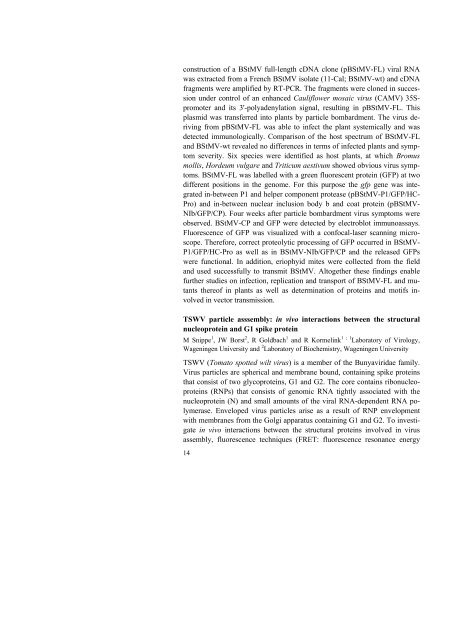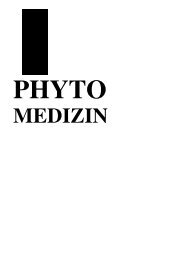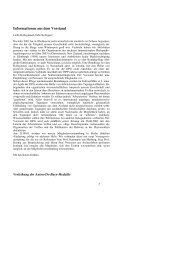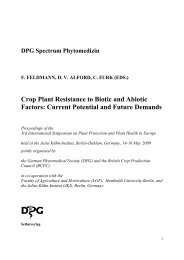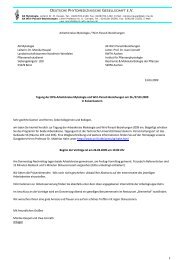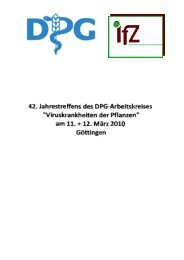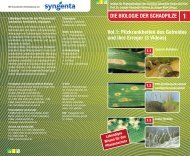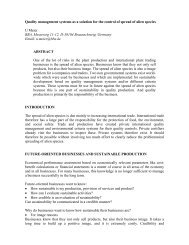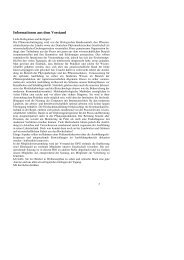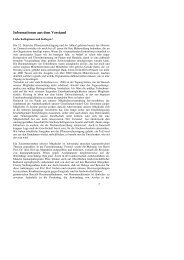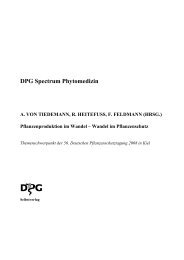PHYTO MEDIZIN Mitteilungen der Deutschen ... - Die DPG
PHYTO MEDIZIN Mitteilungen der Deutschen ... - Die DPG
PHYTO MEDIZIN Mitteilungen der Deutschen ... - Die DPG
Erfolgreiche ePaper selbst erstellen
Machen Sie aus Ihren PDF Publikationen ein blätterbares Flipbook mit unserer einzigartigen Google optimierten e-Paper Software.
construction of a BStMV full-length cDNA clone (pBStMV-FL) viral RNA<br />
was extracted from a French BStMV isolate (11-Cal; BStMV-wt) and cDNA<br />
fragments were amplified by RT-PCR. The fragments were cloned in succession<br />
un<strong>der</strong> control of an enhanced Cauliflower mosaic virus (CAMV) 35Spromoter<br />
and its 3'-polyadenylation signal, resulting in pBStMV-FL. This<br />
plasmid was transferred into plants by particle bombardment. The virus <strong>der</strong>iving<br />
from pBStMV-FL was able to infect the plant systemically and was<br />
detected immunologically. Comparison of the host spectrum of BStMV-FL<br />
and BStMV-wt revealed no differences in terms of infected plants and symptom<br />
severity. Six species were identified as host plants, at which Bromus<br />
mollis, Hordeum vulgare and Triticum aestivum showed obvious virus symptoms.<br />
BStMV-FL was labelled with a green fluorescent protein (GFP) at two<br />
different positions in the genome. For this purpose the gfp gene was integrated<br />
in-between P1 and helper component protease (pBStMV-P1/GFP/HC-<br />
Pro) and in-between nuclear inclusion body b and coat protein (pBStMV-<br />
NIb/GFP/CP). Four weeks after particle bombardment virus symptoms were<br />
observed. BStMV-CP and GFP were detected by electroblot immunoassays.<br />
Fluorescence of GFP was visualized with a confocal-laser scanning microscope.<br />
Therefore, correct proteolytic processing of GFP occurred in BStMV-<br />
P1/GFP/HC-Pro as well as in BStMV-NIb/GFP/CP and the released GFPs<br />
were functional. In addition, eriophyid mites were collected from the field<br />
and used successfully to transmit BStMV. Altogether these findings enable<br />
further studies on infection, replication and transport of BStMV-FL and mutants<br />
thereof in plants as well as determination of proteins and motifs involved<br />
in vector transmission.<br />
TSWV particle asssembly: in vivo interactions between the structural<br />
nucleoprotein and G1 spike protein<br />
M Snippe 1 , JW Borst 2 , R Goldbach 1 and R Kormelink 1 ; 1 Laboratory of Virology,<br />
Wageningen University and 2 Laboratory of Biochemistry, Wageningen University<br />
TSWV (Tomato spotted wilt virus) is a member of the Bunyaviridae family.<br />
Virus particles are spherical and membrane bound, containing spike proteins<br />
that consist of two glycoproteins, G1 and G2. The core contains ribonucleoproteins<br />
(RNPs) that consists of genomic RNA tightly associated with the<br />
nucleoprotein (N) and small amounts of the viral RNA-dependent RNA polymerase.<br />
Enveloped virus particles arise as a result of RNP envelopment<br />
with membranes from the Golgi apparatus containing G1 and G2. To investigate<br />
in vivo interactions between the structural proteins involved in virus<br />
assembly, fluorescence techniques (FRET: fluorescence resonance energy<br />
14


